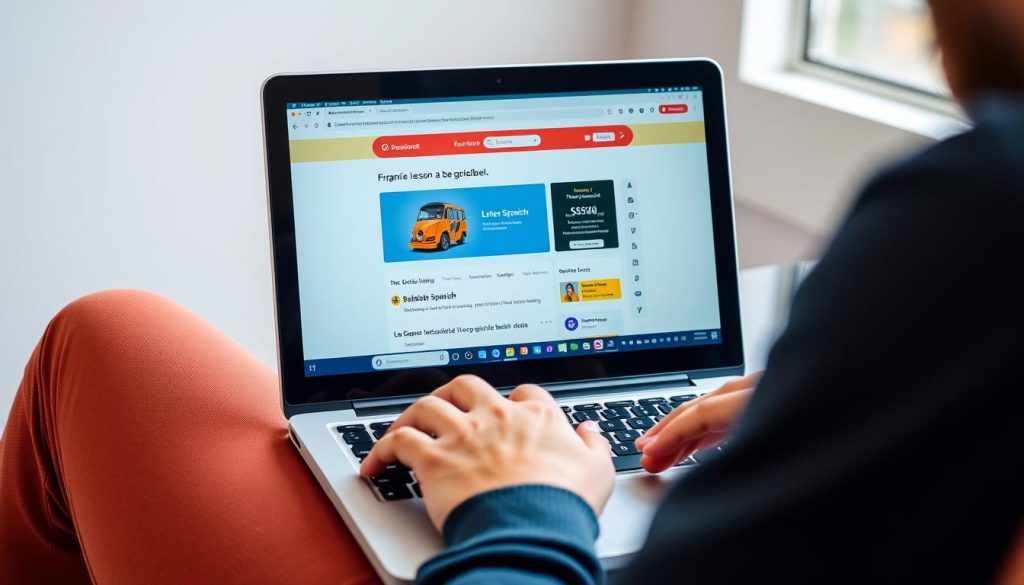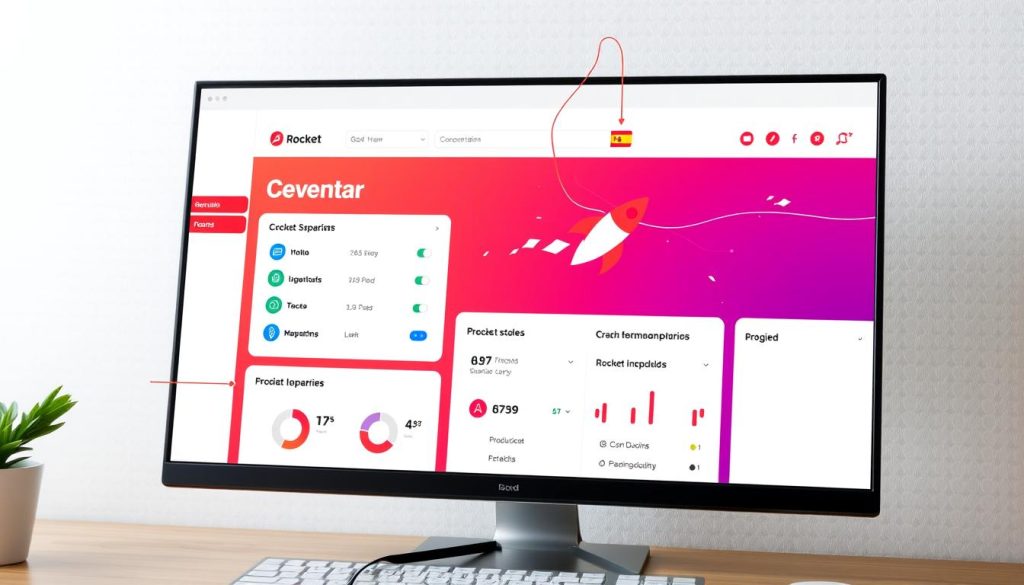With tens of millions of people studying Spanish, it’s clear that this beautiful language has captured the hearts of many. Not only is it a key to understanding the rich cultural heritage of Spain and Latin America, but it also opens doors to new opportunities in travel, business, and personal relationships.
To effectively learn a language, a regular commitment is essential. Studies suggest that dedicating just 15 minutes a day to language study can lead to a simple conversation in about three weeks. This comprehensive guide will explore the most effective methods and resources for learning Spanish quickly through online platforms, covering essential grammar and vocabulary, and reviewing top-rated courses.
By the end of this article, readers will have a clear roadmap for their language learning journey, with actionable steps to achieve conversational fluency efficiently.
Why Learning Spanish Is Worth Your Time
The Spanish language offers a gateway to diverse cultures and economic opportunities. As a widely spoken language, Spanish is an invaluable tool for personal and professional growth.
Personal and Professional Benefits
Learning Spanish can significantly enhance your career prospects, especially in fields related to international business, diplomacy, and education. With the growing influence of Latin American economies, being able to communicate in Spanish can provide a competitive edge in the job market. Moreover, it allows for deeper connections with Spanish-speaking clients, colleagues, and communities.
On a personal level, speaking Spanish opens up new avenues for cultural exploration, travel, and understanding. It enables you to appreciate the rich literary, artistic, and cultural heritage of Spain and Latin America more fully.
Spanish as a Global Language
Spanish is the second most widely spoken native language globally, with approximately 560 million speakers across the world. It is an official language in 20 countries, including Spain, Mexico, and much of Central and South America. The United States also has a significant Spanish-speaking population, making it the second-largest Spanish-speaking country.
Here are some key facts about the global presence of Spanish:
- Spanish is one of the six official languages of the United Nations.
- The language is projected to reach 750 million speakers by 2050.
- It provides access to emerging markets in Latin America, representing significant economic growth potential.
| Region | Number of Spanish Speakers | Official Language Status |
|---|---|---|
| Latin America | 400 million+ | Official in 19 countries |
| United States | 41 million native, 12 million bilingual | Not official, but widely spoken |
| Spain | 46 million | Official |
Setting Realistic Expectations for Fast Spanish Learning
Achieving fluency in Spanish quickly is possible with a clear understanding of the learning process and a consistent effort. To learn Spanish effectively, one must first grasp what it means to learn a language “fast” and how to create a schedule that fosters rapid progress.
What “Fast” Really Means in Language Learning
When it comes to learning a new language, the concept of “fast” can be misleading. In reality, learning Spanish requires a regular commitment and a willingness to challenge oneself. With about 15 minutes of language study a day, you can learn enough to have a simple conversation in about 3 weeks.
The key to fast language learning lies in consistency rather than intensity. Daily practice of 15-30 minutes yields better results than occasional marathon sessions.
Creating an Effective Learning Schedule
To learn Spanish quickly, it’s crucial to adopt an effective approach and method. An optimal learning schedule incorporates multiple learning modalities, including vocabulary building, grammar practice, listening comprehension, speaking practice, and cultural exposure.
- Practice Spanish daily, even if it’s just for a few minutes.
- Incorporate “micro-learning” opportunities throughout your day.
- Schedule regular speaking practice with language exchange partners or tutors.
- Use a spaced repetition principle to review material at increasing intervals.
By understanding what it means to learn “fast” and creating an effective schedule, you can make significant progress in your Spanish learning journey within a relatively short time.
Essential Spanish Basics to Master First
When beginning your Spanish learning journey, focusing on the essential basics is key to making rapid progress. The initial steps involve understanding the core components that will help you communicate effectively.
Key Pronunciation Rules
Mastering Spanish pronunciation is fundamental. It involves learning the correct intonation and pronunciation of vowels and consonants. For instance, the Spanish “c” and “z” are pronounced with a “th” sound in Spain, while in Latin America, they are pronounced as “s.” Correct pronunciation helps in being understood and avoiding confusion.
Foundational Grammar Concepts
Understanding the basic grammar rules is crucial. This includes grasping the concept of ser and estar (both meaning “to be”), Spanish gender rules, and basic verb conjugations. For example, “ser” is used for permanent conditions, while “estar” is used for temporary states.
| Verb | Ser (Permanent) | Estar (Temporary) |
|---|---|---|
| I am | Soy (I am – permanent) | Estoy (I am – temporary) |
| You are | Eres (You are – permanent) | Estás (You are – temporary) |
High-Frequency Vocabulary
Learning high-frequency vocabulary is efficient for rapid communication. Focus on common greetings like “hola” (hello), “buenos días” (good morning), and phrases like “¿Cómo se dice…?” (How do you say…?). Cognates, words that are similar in Spanish and English due to shared Latin roots, can also quickly expand your vocabulary.
- Greetings: hola, buenos días, buenas tardes
- Basic Phrases: ¿Cómo se dice…?, No entiendo
- Cognates: información, restaurante
By focusing on these essential basics, you’ll be well on your way to learning Spanish quickly and effectively.
Top Online Platforms to Learn Spanish Fast
Several top-notch online platforms can help you achieve your goal of learning Spanish fast. These platforms offer a range of tools and methodologies tailored to different learning styles and needs.
Babbel
Babbel’s Spanish course is designed to be comprehensive and engaging, focusing on practical language skills. With interactive lessons and a strong emphasis on pronunciation, Babbel provides a well-rounded learning experience. The platform’s lessons are structured to help learners quickly grasp the fundamentals of Spanish.

Duolingo
Duolingo has revolutionized language learning with its gamified approach, making learning Spanish fun and accessible. The app offers bite-sized lessons that cover vocabulary, grammar, and pronunciation. Duolingo’s interactive format encourages consistent practice, which is key to language acquisition.

Mondly
Mondly is recognized for its innovative approach to language learning, utilizing advanced technologies like augmented reality (AR) and virtual reality (VR) to create immersive lessons. The platform’s focus on conversational skills and practical dialogue scenarios makes it an effective tool for learners aiming to quickly become proficient in Spanish. Mondly’s app is designed to be user-friendly, offering daily lessons and progress tracking.
- Advanced speech recognition technology for precise pronunciation feedback.
- Immersive AR and VR experiences for real-world practice.
- Conversation-focused approach for practical language skills.

By leveraging these top online platforms, learners can significantly enhance their Spanish learning journey, benefiting from structured lessons and interactive tools that cater to various learning preferences.
Comprehensive Spanish Learning Apps
In the quest to learn Spanish quickly, several comprehensive learning apps stand out for their effectiveness and engaging content. These apps offer a range of features and learning approaches tailored to different needs and preferences.
Rosetta Stone
Rosetta Stone is a well-known language learning software that offers an immersive experience with interactive lessons and speech recognition technology to improve pronunciation. It’s designed to teach Spanish in a contextual and intuitive way.

Pimsleur
The Pimsleur Spanish audio course focuses on listening and speaking skills, using a method that emphasizes gradual learning and retention. It’s particularly good for beginners and those who prefer learning through audio lessons.

Rocket Spanish
Rocket Spanish combines comprehensive audio lessons with interactive exercises and cultural insights, offering a balanced approach that develops all four language skills: listening, speaking, reading, and writing. Key features include:
- The program’s voice recognition technology (Rocket Record) allows learners to compare their pronunciation directly with native speakers.
- Rocket Spanish is organized into three levels (Beginner to Advanced), with each level containing multiple modules focused on practical conversation scenarios.
- The platform’s “Language & Culture” lessons provide context for language use, explaining not just how to speak Spanish but when and why certain expressions are appropriate.
- Rocket Spanish employs a “chunking” technique that teaches complete, useful phrases rather than isolated vocabulary.
- The program includes extensive reinforcement activities like flashcards, quizzes, and writing exercises.
- Rocket Spanish offers lifetime access to all purchased course materials with free updates.

Free Spanish Learning Resources Worth Trying
In addition to paid language learning platforms, there are numerous free resources available to help you learn Spanish quickly and effectively. These resources can be used to supplement your learning, providing a more comprehensive understanding of the language.
Coffee Break Spanish Podcast
The Coffee Break Spanish podcast is an excellent resource for learners of all levels. It offers engaging lessons and conversational practice that can help improve your pronunciation and comprehension. With a focus on real-life conversations, it’s an ideal tool for those looking to learn Spanish in a relaxed and enjoyable way.

SpanishDict
SpanishDict is a valuable online resource that provides a comprehensive vocabulary tool, along with grammar guides and verb conjugations. It’s particularly useful for learners looking to expand their words and phrases. By utilizing SpanishDict, you can enhance your understanding of Spanish grammar and vocabulary, making it easier to communicate effectively.

YouTube Spanish Channels
YouTube offers an extensive collection of free Spanish learning channels catering to all proficiency levels. Channels like Butterfly Spanish and Spanish Pod101 are great for beginners, while Dreaming Spanish and Why Not Spanish cater to advanced learners. Visual learning through YouTube videos helps with vocabulary retention by creating strong associations between words and images. Many channels feature native speakers from different regions, exposing learners to authentic accents and colloquial expressions.
- YouTube channels like “Easy Spanish” use street interviews with real Spanish speakers, providing exposure to natural, unscripted conversation.
- Thematic channels focusing on specific interests provide specialized vocabulary in context.
- The comment sections of Spanish learning videos often develop into supportive communities.

How to Learn Spanish Fast Online: Proven Strategies
The key to fast Spanish learning lies in leveraging a range of online resources and methods tailored to your learning style. Effective learning involves a combination of strategies that cater to different aspects of language acquisition.
Daily Immersion Techniques
Daily immersion is crucial for language learning. Techniques include surrounding yourself with the Spanish language through TV shows, music, and podcasts. This constant exposure helps in picking up new vocabulary and phrases naturally. You can also change your phone settings to Spanish to get accustomed to the language in your daily routine.
Implementing daily immersion techniques can be as simple as listening to a Spanish podcast during your commute or watching a Spanish TV show with English subtitles. The goal is to make Spanish a part of your daily life.
Spaced Repetition for Vocabulary Retention
Spaced repetition is a powerful technique for retaining vocabulary. It involves reviewing words at increasingly longer intervals to help solidify them in your long-term memory. Flashcard apps are particularly useful for this method, as they can be programmed to review words at optimal intervals.
| Day | Review Interval | Example Activity |
|---|---|---|
| 1 | Initial Learning | Learn new vocabulary using flashcards |
| 2-3 | First Review | Review flashcards after a day |
| 7 | Second Review | Review flashcards again after a week |
Combining Multiple Learning Methods
Combining different learning methods is an effective approach to learning Spanish. This can include mixing structured courses with interactive apps, language exchange programs, and self-study materials. By diversifying your learning resources, you can keep your study sessions engaging and prevent burnout.
For instance, you might use a language learning app like Duolingo for daily practice, attend a weekly language exchange session, and watch a Spanish movie over the weekend. This varied approach helps in reinforcing your learning from different angles.
Overcoming Common Challenges in Spanish Learning
The journey to Spanish fluency is not without its challenges. Learners often encounter several obstacles that can hinder their progress. However, being aware of these challenges is the first step towards overcoming them.
Dealing with Irregular Verbs
Irregular verbs in Spanish can be daunting due to their unpredictable conjugation patterns. To master them, it’s essential to focus on the most commonly used irregular verbs first. Practicing their conjugations in context through sentences and conversations can help solidify them in your memory. Additionally, using flashcards can be an effective method for memorizing irregular verb forms.
Mastering Spanish Gender Rules
Spanish nouns have gender, and mastering the rules governing this aspect is crucial. While there are exceptions, many nouns follow specific patterns. For instance, nouns ending in “-o” are typically masculine, while those ending in “-a” are often feminine. Understanding these patterns and practicing with exercises can help learners become more comfortable with noun genders. It’s also helpful to learn nouns with their corresponding articles to reinforce their gender.
Improving Your Spanish Accent
Improving your Spanish accent involves more than just mastering individual sounds; it requires attention to Spanish rhythm and intonation. Practicing with native speakers, either in person or through online platforms, can significantly improve your accent. Techniques like “shadowing”—repeating what a native speaker says immediately after they say it—can also be very effective. Moreover, focusing on the physical aspects of pronunciation, such as tongue placement and lip rounding, can enhance your overall pronunciation.
By addressing these common challenges, learners can significantly improve their Spanish skills and move closer to fluency.
Finding Spanish Conversation Partners Online
One of the most effective ways to improve your Spanish skills is by engaging in online conversations with native speakers. This approach not only enhances your speaking abilities but also provides insight into cultural nuances and everyday language usage.
To find the right conversation partners, you can explore various online platforms designed to connect learners with native speakers or professional teachers.
Language Exchange Platforms
Language exchange websites are an excellent resource for finding conversation partners. They allow you to practice your Spanish skills while helping others learn your native language. Some popular platforms include:
- italki: A platform that connects learners with language teachers for one-on-one lessons.
- Tandem: An app that facilitates language exchange between native speakers and learners.

Online Spanish Tutoring Services
For more structured lessons, consider online tutoring services that offer learning Spanish courses tailored to your needs. These platforms provide access to professional teachers who can guide you through your language learning journey.
- iTalki: Connects learners with professional Spanish teachers for personalized lessons.
- Preply: Offers one-on-one tutoring with experienced teachers.
- Verbling: Provides live online classes and one-on-one tutoring.

By leveraging these online resources, you can significantly improve your Spanish skills and become proficient in the language.
Tracking Your Spanish Learning Progress
Regularly evaluating your Spanish skills helps you stay on track and adjust your learning strategy. Effective tracking of your progress is crucial for achieving your goals in Spanish learning.
Setting Measurable Goals
To track your progress, you first need to set measurable goals. This involves defining specific, achievable milestones in your Spanish learning journey. For instance, you might aim to hold a 10-minute conversation with a native speaker or understand a Spanish TV show without subtitles within a certain time frame. By setting such goals, you can focus your efforts and have clear targets to work towards.
Utilizing tools like language learning apps or spreadsheets can help you monitor your progress. For example, you can track the number of new vocabulary words learned each day or the amount of time spent practicing speaking or listening.
Testing Your Spanish Proficiency
To assess your Spanish level, you can use various methods. One approach is through formal assessment using standardized tests like the DELE or SIELE, which provide internationally recognized certification across six levels (A1-C2).
Other methods include:
- Online placement tests from language schools and platforms like SpanishDict or Cervantes Institute, which offer free preliminary assessments to identify your approximate CEFR level.
- Self-assessment using “can-do” statements from the CEFR framework, providing a structured way to evaluate your functional abilities.
- Recording regular speaking samples and reviewing them over time to notice improvements in fluency and accuracy.
- Tracking quantitative metrics such as vocabulary size or listening comprehension percentage.
- Participating in language exchanges with consistent partners who can note changes in your conversations abilities.
- Creating periodic “challenge tasks” that simulate real-world language use.
By incorporating these methods into your learning routine, you can gain a comprehensive understanding of your progress and make informed adjustments to your learning strategy, potentially with the guidance of a teacher or mentor.
![]()
Conclusion: Your Path to Spanish Fluency
The path to Spanish fluency is multifaceted, involving not just language skills, but also cultural understanding and personal dedication. As you’ve explored through this comprehensive guide, achieving proficiency in Spanish requires a combination of effective strategies, the right resources, and a commitment to consistent practice.
To learn Spanish efficiently, it’s crucial to maintain a growth mindset, embracing challenges as opportunities for growth rather than obstacles. Consistency is key; dedicating 15-30 minutes daily to language practice yields better results than sporadic, intense study sessions.
Personalizing your learning Spanish approach based on your goals and preferences enhances engagement and retention. Whether your interests lie in travel, business, or cultural appreciation, tailoring your study plan can make the process more enjoyable and rewarding. Ultimately, the journey to fluency in Spanish is a continuum, with the language offering new nuances and cultural insights to discover at every level.
By adopting these strategies and maintaining your commitment, you’ll not only achieve your Spanish learning goals but also enrich your life with the beauty and diversity of the Spanish language.


